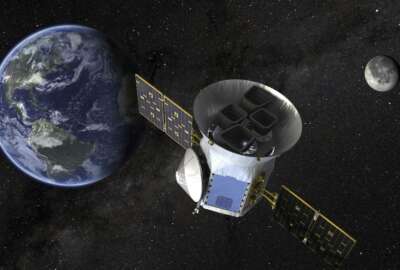

Few technologies have had as much impact on military, civilian, governmental and commercial activities as geographic information and intelligence.
Best listening experience is on Chrome, Firefox or Safari. Subscribe to Federal Drive’s daily audio interviews on Apple Podcasts or PodcastOne.
Few technologies have had as much impact on military, civilian, governmental and commercial activities as geographic information and intelligence. GEOINT, as practitioners call it, continues to develop and morph. In its latest status report, the U.S. Geospatial Intelligence Foundation detailed these trends. For highlights, Federal Drive with Tom Temin turned to foundation Chairman Jeffrey Harris, and its Vice President of Programs Ronda Schrenk.
Interview transcript:
Tom Temin: Mr. Harris, good to have you on.
Jeffrey Harris: Great to be here.
Tom Temin: And Ms. Schrenk, good to have you on.
Ronda Schrenk: Thanks for having us.
Tom Temin: Let’s start, I think first, by maybe separating out the differences between geographic information systems and technology, which is used by almost everybody nowadays, and geographic intelligence because I think one draws from the other. But give us that distinction,
Jeffrey Harris: What a great question. Everything’s about location. And we got all these things about location, and then had to organize the data. And so we said, well don’t organize data. It’s information systems. So why don’t we have geographic information systems? And then people like Ronda said, “Hey, what about the humans? What about us analysts? What about us operators?” And so we said when the GIS systems – and in the report that we’re talking about today, we talked about that’s sort of the, the wood, the timber – and when you put it together into a framework, a house, it becomes GEOINT, which is how you use the information, this geographic information to do good stuff.
Tom Temin: Got it. And we should point out that you both have long histories in intelligence for the federal government. Ronda, tell us about how the GEOINT idea kind of came in over the years?
Ronda Schrenk: So in the past, we had a imagery intelligence workforce that was separate from a mapping or cartography workforce. And just about in the 1995-1996 timeframe, the idea came across the government of, “Wow, wouldn’t did these work well together?” Geographic information systems were beginning to take off. And we had these two symbiotic workforces across the federal government that were joined together and became known as the National Imagery and Mapping Agency, and later, the National Geospatial Intelligence Agency. That workforce – I was part of that workforce, Jeff was a part of that workforce back in the day, where we operated in a closed and classified environment, and – had source material or imagery and intelligence data wasn’t readily available outside of the government channels. And if you think about it, like driving a car, when we used to go from point A to point B, we would use written directions, we would use our memory and for agility, we had a map book in the back or some people just drove until they could figure it out. Today, we operate in a much different environment. Today’s workforce has grown up in this human-machine teaming environment. And if you compare it to the same thing of going from A to B, we asked our car now, how do I get there? Or the GPS on our phone to tell us not only how to navigate there, but also to provide real-time environmental conditions, like traffic or road conditions. This is the epitome of human machine teaming and how our geospatial intelligence analytic workforce is now and will continue to operate going forward.
Tom Temin: All right, and now the GEOINT Foundation has put out a look at what’s ahead, as I guess you do periodically. Let’s discuss some of the principal technology trends that the foundation sees ahead. A couple that caught my eye were use of synthetic data and next-gen GEOINT systems. Talk about some of the major trends.
Jeffrey Harris: We live in this sort of thumb-driven information technology. And we’re also quoting that about 80% of all business data has this location underpinning. And so Tom, there’s thing called the internet of things, which is all of these cloud-connected devices that talk to each other. And they’re all sort of broadcasting their location. And so if I get location and time and put it in a context of fabric of understanding, I can amalgamate this data together to go tell a very different story. So you asked a great question that says, All right, when I go to Hollywood, we see the operators and the analysts, like run at a keyboard, assembling all these diverse data sets, and putting them together and doing magic that always causes a good, typically a good, happy outcome. And we go to the movies and we expect that this happens all the time. And so the visualization of how this data comes together, Hollywood has owned for a while. And now when we get into our cars, we expect a good experience where it’s predicting traffic and rerouting us automatically as we go from point A to point B, as Ronda pointed out. And so the synthetic data environment, Tom, is coming right along that says, instead of working in the lab to put it together, we’re putting together these, this fabric of information that allows the augmented reality and the reality to come together. And we’re infusing it with the information that’s coming from satellites, from airplanes, from our autonomous cars from these internet of things. And as we put that together, we’re putting what we know. And we’re adding to it what we are postulating. And so I’m taking real and synthetic and I’m merging it together. So now for the Army, I have a training environment – One World Terrain. For the city planners, I can look and see where I have sidewalk breaks for the American Disabilities Act. And if I’m digging a hole, I can dig a hole and not disrupt the power coming into your home, since you’re working for today. So that’s synthetic data. So it’s real data coming together with postulated data. And now the IT backbone and the cloud processing, allows advantaged and disadvantaged users, people that have lots of compute power and those that may not to work in this increasingly mobile environment.
Tom Temin: We’re speaking with Jeff Harris – he’s chairman of the board – and with Ronda Schrenk – she’s vice president of programs – both at the U.S. Geospatial Intelligence Foundation. And one of the other looks ahead in the annual report here is developing the geographic intelligence workforce. And what are some of the issues there? We hear about cybersecurity workforce a lot, not so much about GEOINT workforce.
Jeffrey Harris: The workforce is driving towards increased professionalization and the USGIF, the foundation, focuses on building community, advancing the tradecraft and accelerating innovation. And it’s taking the new tools and the smart value add of the people and putting them together. And Ronda actually coordinates our working groups and brings industry and academia together.
Ronda Schrenk: Yes, absolutely. Workforce today, as a difference from when I came in, is that they really need to be tech savvy, agile in their work flows and have solid critical thinking skills. And I would say everything that we’re seeing at the university level, the future is bright. Jeff and I were at a symposium that was hosted by our foundation last fall. We were listening to a presentation from two George Mason University students, and both of us at the same time sort of looked at each other and scratched our heads and said, “Oh, is that not classified?” The combination of analytic process being taught and developed at the collegiate level, as well as the democratization of GEOINT data is driving tremendous progress across the community. And then to build on that – partnerships. And that’s, Jeff, thank you for bringing up our working group efforts. No one can go it alone and be as successful as the whole, and one of our top focus areas for the foundation, and by extension, the GEOINT communit,y is partnerships. And one of the ways that USGIF is able to propel that collaborative spirit is through our working group. So we’re homeroom to eight active working groups that focus on today’s most pressing issues, including artificial intelligence and machine learning. We recently stood up a working group focused on modeling and simulation, as well as a young professionals group, to name a few.
Tom Temin: And with the democratization of all of this data and capability and the abstraction of the technology so that it’s easier to use, how does the intelligence community – do you think your old stomping grounds – keep the edge that it needs above everybody else because of the national security interest that it basically owns, that the other users don’t have?
Jeffrey Harris: This is really very interesting to think about, because the intelligence community has customers. And the customers are from the president on down, the policymakers – president, Congress, and the operators, the military, and the first responders – think FEMA. They need to understand the base of what, everything’s going on. And they think – have to understand a little bit about intention. And they need to take those intentions and predict what may or may not happen. And so all of these technologies coming together, and all of this information allows them to create a much better base case. And so they can take the base case that’s made up of both classified and unclassified information. They can take reporting from attaches in the State Department and get context from that. And they get to interact with policymakers and address their real concerns. So the intelligence community can put out collaboratively with their interagency partners and working with their consumers, a much richer product that’s focusing on the nuance of what’s about to happen. What are they thinking? And what are their options to give our policymakers good options? So they’re embracing of traditional tradecraft, as they would say, with these emerging technologies and innovations, allow them to very excited live in this sort of cloud enabled world where they have a one foot in, what we would say “behind the green door” where it’s classified, but very engaged with the world in academia. That would be very different than –
Tom Temin: Sounds like everyone has the same instruments to choose from, but the intelligence community has its own orchestra to pick and choose.
Jeffrey Harris: A very good analogy.
Tom Temin: Jeff Harris is chairman of the board and Ronda Schrenk is the vice president of programs at the U.S. Geospatial Intelligence Foundation. Thank you both so much for joining me.
Jeffrey Harris: Tom, it was great to join with you today, thank you.
Ronda Schrenk: Tom, thank you so much for having us.
Tom Temin: We’ll post this interview and a link to their report at www.FederalNewsNetwork.com/FederalDrive. Hear the Federal Drive wherever on earth you are. Subscribe at Apple Podcasts or Podcastone.
Copyright © 2025 Federal News Network. All rights reserved. This website is not intended for users located within the European Economic Area.
Tom Temin is host of the Federal Drive and has been providing insight on federal technology and management issues for more than 30 years.
Follow @tteminWFED


